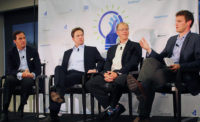The San Diego Association of Governments “missed red flags” and demonstrated “severe lapses in judgment” in its revenue estimates for a proposed half-cent sales tax, according to investigators.
SANDAG hired law firm Hueston Hennigan LLP to conduct an independent investigation of its inflated revenue forecast for Measure A, a failed 2016 ballot initiative that sought to establish a new sales tax for the San Diego region. Investigators found that overlooked data-entry errors dating from 2004 had resulted in years of faulty forecasts.
The agency missed opportunities to unearth those forecasting errors and demonstrated “severe lapses in judgment in terms of how executives and others responded to inquiries after the forecaster error was discovered,” John Hueston, an investigator with Hueston Hennigan, told SANDAG’s board of directors on Aug. 4.
SANDAG had endorsed Measure A, promising the additional sales tax would generate $18 billion in tax revenue over 40 years for regional transportation needs.
But in October 2016, the local press reported that the revenue estimates were inflated by billions of dollars. A month later, Measure A lost at the polls and SANDAG’s board commissioned an independent inquiry to find out who at SANDAG knew about the overstated estimates and when they knew. Hueston’s firm interviewed 22 witnesses, including employees and board members, and reviewed more than 50,000 emails and other documents.
A core problem was SANDAG’s longtime use of its Demographic and Economic Forecasting Model (DEFM), Hueston told the board. This computer program takes local, regional, national and third-party data and generates a comprehensive forecast for the San Diego region.
The investigative report says that, in 2004, SANDAG staff incorrectly inputted third-party data into DEFM, which caused it to forecast an inflated growth rate for regional income. In turn, this mistake led to inflated taxable retail-sales projections and revenue from the passage of Measure A, the report says. SANDAG uses DEFM about every three years to generate new regional growth forecasts for various transportation plans.
Investigators say that, after the aggregation error was introduced into DEFM in 2004, it stayed in the system and caused problems to subsequent DEFM predictions in 2006 and after. The report found that no member of SANDAG’s modeling team noticed the aggregation error, nor did a previous expert review panel.
Hueston told the board that DEFM was so complicated that very few SANDAG employees fully understood how to use it. The report further found that when “certain staff” discovered errors in the model and recommended a new computer program, SANDAG’s then-chief economist Marney Cox declined, and the problem persisted. In July 2015, Cox used DEFM to generate the projected sales-tax revenue for Measure A.
Two days after Measure A failed to pass, SANDAG staff members finally discovered that the source of the inflated figures was an aggregation error introduced years earlier into DEFM, the report found.
Other “lapses in judgment” included a hidden folder for documents related to DEFM errors; further, following the discovery of the modeling errors, SANDAG decided to hold a staff meeting in which employees were instructed by council to delete draft documents after 60 days, the report noted. While this was consistent with SANDAG’s retention policy, Hueston said it gave the impression of wrongdoing.
Embattled SANDAG Executive Director Gary Gallegos, who had announced plans to retire at the end of the year, now has requested retirement as early as Aug. 18, according to a SANDAG spokesperson. The request is pending board approval.
Other fallout from the report includes a SANDAG initiative to “strengthen the transparency, accountability and accuracy of the agency’s modeling and forecasting processes.” The agency’s technical staff has organized into several teams to look into reforms as well as bring in outside experts to review its processes and develop enhancements for board consideration.
Laura Coté, SANDAG director of administration, says the agency has stopped using DEFM economic forecasts and now is “using a consensus forecast from Moody’s, IHS Global and Woods & Poole while we rebuild our forecasting model from the ground up.”





Post a comment to this article
Report Abusive Comment